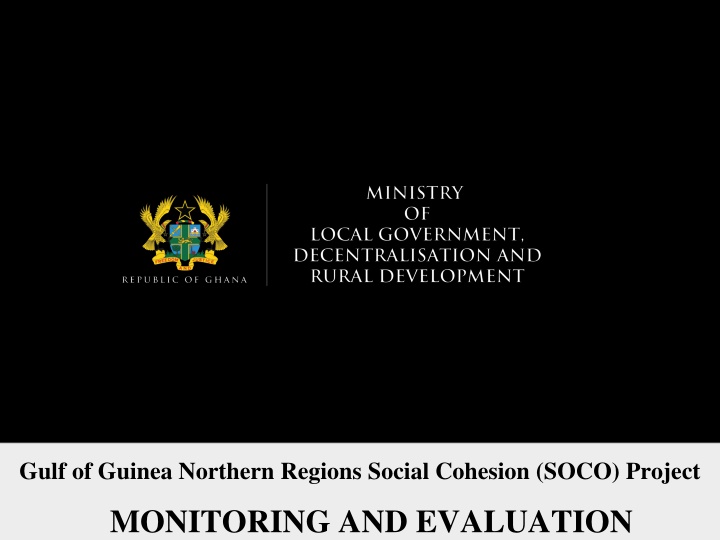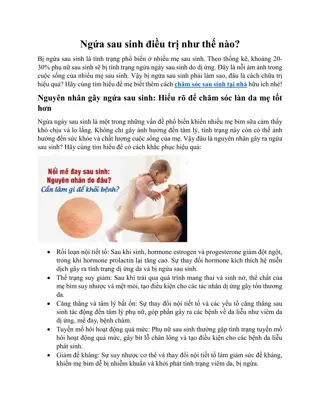
Social Cohesion Project Monitoring and Evaluation in Gulf of Guinea Northern Regions
The Gulf of Guinea Northern Regions Social Cohesion (SOCO) Project focuses on monitoring and evaluating stakeholder engagement, progress, and outcomes to ensure effective implementation. Monitoring involves regular assessment to improve activities, while evaluation measures impact and sustainability. A Mid-Term Review is conducted to assess progress, and beneficiary surveys inform decision-making. Participation of primary stakeholders is critical for successful project execution.
Download Presentation

Please find below an Image/Link to download the presentation.
The content on the website is provided AS IS for your information and personal use only. It may not be sold, licensed, or shared on other websites without obtaining consent from the author. If you encounter any issues during the download, it is possible that the publisher has removed the file from their server.
You are allowed to download the files provided on this website for personal or commercial use, subject to the condition that they are used lawfully. All files are the property of their respective owners.
The content on the website is provided AS IS for your information and personal use only. It may not be sold, licensed, or shared on other websites without obtaining consent from the author.
E N D
Presentation Transcript
Gulf of Guinea Northern Regions Social Cohesion (SOCO) Project MONITORING AND EVALUATION
will to allow track project how 1. Monitoring stakeholders project are towards outputs objectives/outcomes is undertaken regularly to ensure that the right things are being done at the right time. activities/interventions being implemented achievement and some of specific The need to conduct M&E on SOCO Project 2. This a continuous activity 3. It measures progress towards implementation plan/action plan helps implementation challenges and mitigation measures/solution offered implementation. of work- 4. Monitoring to identify to improve
1. Data from Monitoring provides evidence for decision making managerial 2. Monitoring accountability donors and stakeholders with the results implementation ensures providing by The need to conduct M&E on SOCO Project of project 3. Monitoring is done internally by project monitoring tools/templates staff using 4. Monitoring template captures all output indicators some immediate indicators and outcome
EVALUATION is a periodic assessment of changes (Positive and Negative) in the lives of target population attributable to the project. It assesses the extent to which project overall objectives and outcomes are being achieved (Effectiveness) The need to conduct M&E on SOCO Project It provides lessons for improving project design , programming implementation and It assesses the extent to which the project is being efficient with the use of resources , whether the benefits will last (sustainability), and the difference being made by the intervention(Impact) A baseline survey will be undertaken to form the basis for changes brought about by the project. tracking future
A Mid-Term Review (MTR) will be conducted to assess the progress being made towards meeting the PDO and intermediate outcomes and modifications thereof levels any propose The need to conduct M&E on SOCO Project Two conducted throughout the project s lifetime to inform indicators (mostly on beneficiaries' perceptions). beneficiary surveys will be survey-based 1st survey in Year 2 to inform Mid- Term Result (MTR) and 2nd survey in Year 5 (final year).
PM&E primary stakeholders involvement as active participants interventions by them taking the lead in tracking progress towards results and deciding on corrective action. is about strengthening 1. in and jointly analysing agreed PARTICIPATORY MONITORING AND EVALUATION This demand-led planning and decision- making and improved accountability. approach contributes to 2. Local stakeholders determine what should be measured and how and when monitoring and should be done. 3. evaluation It empowers community members, improves commitment , ownership and sustainability 4.
MONITORING AND EVALUATION MONITORING AND EVALUATION RESPONSIBILiTIES RESPONSIBILiTIES ACROSS LEVELS ACROSS LEVELS LEVEL ROLE Regional Level The RPCU under the RCC, with support from the Zonal Coordinators, will collate and harmonise the project s work plan and budget from participating Districts within the region and undertake quarterly monitoring of project implementation in districts within their jurisdiction. District Level The DA shall be responsible for the overall project implementation at the local level. The Planning Unit shall review and incorporate project activities into the DMTDP and DA s AAP. The Budget Unit will incorporate Project budgets into the Composite Budget and the Annual Budget estimate of the Assembly
MONITORING AND EVALUATION MONITORING AND EVALUATION RESPONSILBILTIES ACROSS LEVELS RESPONSILBILTIES ACROSS LEVELS LEVEL ROLE Distric t Level The DPCU , in collaboration with the Zonal Office and the PIU, ensures appropriate sub-project monitoring and supervision Districts will undertake monthly and quarterly monitoring using a monitoring template which covers the results framework indicators . DAs will also monitor activities at the community level reported by the CFs and CPICs. DA Officers will be given a monitoring template with indicators to look out for when they go to the field to undertake monitoring. design, implementation , Comm unity Level CFs assigned to a particular community/cluster are responsible for collecting basic data under the Comprehensive Results Framework to feed the Project M&E system CFs and CPICs will undertake regular monitoring of subproject progress. The CPICs will report all cases of complaints and harassment to the Assembly through the Community Facilitator (CFs).
WHAT WILL BE MONITORED BY COMMUNITY WHAT WILL BE MONITORED BY COMMUNITY ACTORS ACTORS 1. 2. 3. 4. 5. 6. 7. Planned activities in the community action plan Expected start date and actual start date Expected end date and actual end date Expected and actual number of persons to be employed Expected cost and actual cost of the project Level of community participation on the project Materials being supplied to the site and how the materials are being used Flow of resources for carrying out the project Adherence to environmental and social requirements 10. Adherence to technical specification of the project 11. Pace of Progress of work 8. 9.
MONITORING PROCEDURES MONITORING PROCEDURES 1. Field monitoring report formats would be developed and used by all field officers at the ZCOs, RCCs and DAs to ensure harmony in reporting relevant information, effecting corrective action and providing feedback. 2. DAs and ZCOs will be provided with the necessary support in the form of required logistics and training to make short video documentation with commentary at the start of every intervention or stage of activity to give a baseline impression. 3. Video documentation would be done for a sample of communities for each type of intervention and for peculiar/extra-ordinary situations that can form the basis of case studies.
REPORTING REPORTING During implementation, reports will emanate from the community level through the CFs. The two sets of facilitators will report to the district, regional and zonal to the national level. 1. At the Community level, the CFs shall be responsible for reporting and to ensure standardisation and uniformity of reports emanating from the various intervention communities, the latter will be provided with simple templates with which they will be required to compile monthly data and submit same to the DA for analysis and collation into a monthly report. 2. At the DA level, the Focal persons for the departments implementing activities in sub-components areas under components 1 and 2 working through the DPCU (with the DCD as head) shall be responsible for reporting. 3.
REPORTING REPORTING 4. The ZCO shall collate inputs from the various Implementing DAs on the components into a quarterly progress report and submit the same to the PIU as a part of the entire Zonal Report within 20 days after the end of the quarter using the Project MIS system. 5. From the Quarterly Reports received from the zones, the M&E Specialist shall compile national quarterly reports on the technical and financial aspects of the project and submit them to the MLGDRD through the Project Coordinator. 6. Quarterly progress reports shall be submitted to the World Bank through the Chief Director of MLGDRD at most 30 days after the end of the quarter.






















